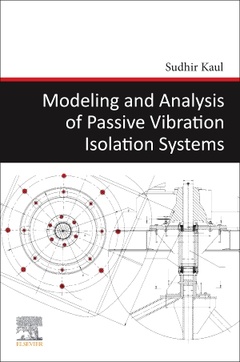Modeling and Analysis of Passive Vibration Isolation Systems
Langue : Anglais
Auteur : Kaul Sudhir

Modeling and Analysis of Passive Vibration Isolation Systems discusses a wide range of dynamic models that can be used for the design and analysis of passive vibration isolation systems. These models range from linear viscoelastic single degree-of-freedom systems to multiple degree-of-freedom nonlinear systems. They can be used to evaluate hyperelasticity and creep, and to represent the inertia effect for an evaluation of vibroacoustic characteristics at high frequencies. This book also highlights specific nonlinear behavior, displacement-limiting designs, hyperelastic behavior, and characteristics associated with elastomeric materials for each model. It also identifies key attributes, limitations, and constraints, providing a holistic reference that can be used for the design and analysis of passive vibration isolators. Modeling and Analysis of Passive Vibration Isolation Systems serves as a reference for engineers and researchers involved in the design, development, modeling, analysis, and testing of passive vibration isolation systems and as a reference for a graduate course in vibration modeling and analysis.
1. Vibration isolation—background
2. Viscoelasticmodeling—passive vibration isolators
3. Vibration isolation system modeling
4. Vibration isolation systems—nonlinearmodels
5. Modeling elastomer characteristics
6. Modeling inertia effect
7. Elastomeric vibration isolator design
2. Viscoelasticmodeling—passive vibration isolators
3. Vibration isolation system modeling
4. Vibration isolation systems—nonlinearmodels
5. Modeling elastomer characteristics
6. Modeling inertia effect
7. Elastomeric vibration isolator design
Researchers in automotive, aerospace, and civil engineering and heavy machinery; Professional automotive, aerospace, and civil engineers
Sudhir Kaul is an Associate Professor of Mechanical Engineering in the School of Engineering and Technology at Western Carolina University in North Carolina, USA. Dr. Kaul earned his PhD from the University of Wisconsin-Milwaukee in 2006 and has held academic positions since 2008. His industry experiences include development of vibration isolation systems, design and development of motorcycle powertrains, and design of hydraulic systems. His research interests include dynamic modeling for vibration isolation, motorcycle dynamics, and fracture diagnostics. He has published more than sixty articles in peer-reviewed journals and conference proceedings.
- Outlines the use of multiple models for optimal passive vibration isolation system design
- Discusses the effects system design has on subsequent product development components and parameters
- Includes applied examples from the automotive, aerospace, civil engineering and machine tool industries
- Presents models that can be extended or modified to investigate different means of passive isolation, nonlinearities, and specific design configurations
- Considers specific elastomer characteristics such as Mullins and Payne effects for theoretical modeling and analysis
Date de parution : 07-2021
Ouvrage de 234 p.
15.2x22.8 cm
Thèmes de Modeling and Analysis of Passive Vibration Isolation Systems :
© 2024 LAVOISIER S.A.S.



